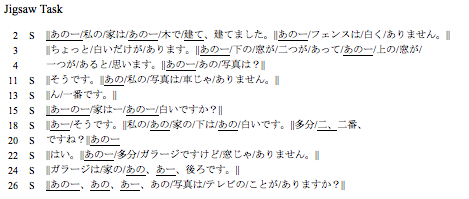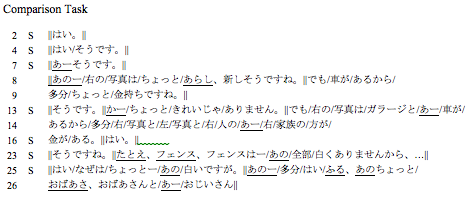Complexity: Activity 2
Impact of task on AS-units
Let’s take a more precise look at the impact of task on the syntactic complexity of a learner language using a commonly used unit called AS-unit. An AS-unit is defined as “a single speaker’s utterance consisting of an independent clause or subclausal unit, together with any subordinate clause(s) associated with it” (Foster, Tonkyn, and Wigglesworth, 2000, p. 365).
An independent clause has a subject and a tensed verb, and can stand alone as a sentence.
‘太郎は今日遅刻した。(Taro was late today.)’
‘彼女は必死になって車の鍵を探している。(She’s frantically looking for her car keys.)’
A subclausal unit is a segment of speech or writing that can be expanded into a full clause by recovering elements that were omitted or a minor utterance.
‘行きたい?(Want to go?)’
‘数学。(Math.)’ in answer to a question such as ‘今日、何を勉強したの?(What did you study
today?)’
‘そうです。(That’s right.)’
‘ありがとう。(Thank you.)’
A subordinate clause would be considered a sentence fragment if it were used alone.
‘今日は雨が降っているから、(because it is raining today)’
‘あの木の下で本を読んでいる<女の子は>… (<The girl> who is reading a book under that
tree…)’
In this activity we use language segments from Sebastian’s Jigsaw and Comparison tasks with the approximately equal number of phrases*. Our two samples below have slightly different phrase counts so we could have complete AS-units. False starts, hesitations, and repetitions were not included in the phrase count; they are underlined in the text below. You might decide to include these if you think these are important for some reason.
- Compare the number of AS-units in the two segments. Then calculate the average length of the AS-units for each segment (mean number of phrases per AS-unit). How many of the units contain subordinate clauses?
- What other grammatical constructions do you see that show syntactic complexity in this segment?
* Because it is less complicated, we have decided to count the number of 文節 (phrases), counting 自立語 (independent words) and 付属語 (ancillary words) together (e.g., counting a noun with a particle as one phrase). We think this is better than counting the number of 単語(words) with 自立語 (independent words) and 付属語 (ancillary words) counted separately (e.g., where a noun and a particle would count as two words).
From Sebastian’s Jigsaw Task
From Sebastian’s Comparison Task

Please type your answers to the questions in the box below.
When you have finished typing your answer, click to compare your response with the Learner Language staff response.
- AS-unit analysis
| Sebastian’s Jigsaw Task | Sebastian’s Comparison Task |
|---|---|
| 51 phrases 16 AS-Units Mean number of phrases per AS-unit: 3.2 1 Subordinate clause: あのー/下の/窓が/二つが/あって/あのー/上の/窓が/一つが/あると/思います (Lines 3-4) |
49 phrases 12 AS-Units Mean number of phrases per AS-unit: 4.1 2 adverbial clauses: でも/車が/あるから/多分/ちょっと/金持ちですね。(Lines 8-9) でも/右のでも/写真は/ガラージと/あー/車が/あるから/多分/右/写真と/左/写真と/右/人の/あー/右/家族の/方が/ 金が/ある。(Lines 13-14 & 16) |
- Quantitatively, Sebastian produces fewer AS-units in the Comparison Task than in the Jigsaw Task. This means that the average length of his AS-units in the Comparison is longer than that in the Jigsaw. While he produces one subordinate clause in the Jigsaw Task, he produces 2 adverbial clauses in the Comparison Task. It leads us to think that to some extent his production is more syntactically complex in the Comparison task than in the Jigsaw Task. In the Comparison Task, his adverbial clauses function to cite evidence for his inferences. Other possible subordinate structures missing in Sebastian’s speech that a native speaker might have used include ‘〜を考えると(given…),’ ‘この写真を見る限りでは(As far as I can see/this picture shows),’ and the like.
